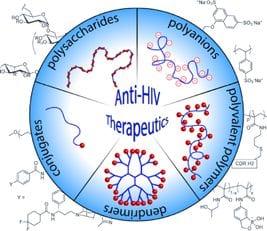Despite decades of research, HIV continues to be a significant global health issue. With particularly high rates of occurrence in the developing world, it is estimated that a new case is identified every 5 minutes. Polymer therapeutics are used at several stages of the HIV life cycle, both in reducing transmission and infection, and in the treatment of infected individuals. The constant development of new therapies is required due to increasing viral resistance to existing drugs, and the toxicity of many established treatments. A review in Macromolecular Bioscience, featured in the Best of Macromolecular Journals Edition 2016 and now available free, highlights the current uses and potential new development of polymeric therapies in the fight against HIV.
 Polyanionic, peptide, protein, polysaccharide and synthetic drug ligands are presented which, combined with synthetic macromolecules, could provide novel and low toxicity HIV therapies. These therapeutics can inhibit HIV both extracellularly and intracellularly at critical stages of the virus life cycle. Polymeric therapeutics offer advantages over non-polymeric therapies, such as increased stability and efficacy, and the ability to act as a scaffold. The review also summarizes the HIV virus life cycle and briefly discusses US Food and Drug Administration approved non-polymeric therapies, forming a comprehensive overview of HIV treatments.
Polyanionic, peptide, protein, polysaccharide and synthetic drug ligands are presented which, combined with synthetic macromolecules, could provide novel and low toxicity HIV therapies. These therapeutics can inhibit HIV both extracellularly and intracellularly at critical stages of the virus life cycle. Polymeric therapeutics offer advantages over non-polymeric therapies, such as increased stability and efficacy, and the ability to act as a scaffold. The review also summarizes the HIV virus life cycle and briefly discusses US Food and Drug Administration approved non-polymeric therapies, forming a comprehensive overview of HIV treatments.
The Best of Macromolecular Journals Edition 2016 is a special reprint issue highlighting the most impressive contributions from over one thousand articles published across the Macromolecular Journals family in 2015. All of these articles are free to access for one year. Find out more here.

















